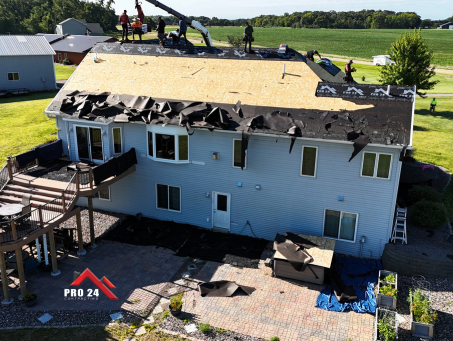Storms are among nature’s most unpredictable and destructive forces, leaving homeowners with the daunting task of repairing damage and safeguarding their property. Whether it’s high winds tearing off shingles, hail denting siding, or torrential rain flooding basements, storm damage can affect every part of your home. The key to managing this damage lies in swift action, thorough assessment, and knowing when to call in professionals.
In this comprehensive guide, we’ll cover everything homeowners need to know about storm damage repair—from assessing the damage to taking preventative measures for the future.
1. Understanding Storm Damage Repair
Storm damage repair is a multifaceted process that requires a keen understanding of how various weather elements can affect different parts of your home. The damage caused by storms isn’t limited to what’s immediately visible—it often involves hidden problems that can worsen over time if left untreated. Here’s a more in-depth look at what storm damage repair entails, why it’s crucial, and the types of damage storms can inflict on your home.
i. Why Storm Damage Repair Is Crucial
The aftermath of a storm often brings a sense of relief that the worst is over, but the damage it leaves behind can be a ticking time bomb for your home. Here’s why addressing storm damage promptly is essential:
- Preventing Escalation. What may seem like minor issues, such as a small roof leak or a crack in the siding, can snowball into major problems like structural damage, mold growth, or interior water damage if left unaddressed.
- Maintaining Property Value. Visible damage to your home’s roof, siding, or exterior not only affects its aesthetic appeal but can also decrease its market value. Potential buyers will see storm damage as a red flag, making repairs a priority for homeowners looking to sell.
- Ensuring Safety. Storm damage can compromise the structural integrity of your home, putting your family at risk. Loose shingles, exposed electrical wiring, or sagging gutters pose significant hazards.
- Insurance Compliance. Many insurance policies require homeowners to mitigate further damage after a storm. Ignoring repairs may lead to denied claims, leaving you to shoulder repair costs out of pocket.
ii. Types of Storm Damage
Storms come in many forms, and each type brings its own unique challenges. Here’s how common weather events can impact your home:
1. Wind Damage
High winds are among the most destructive elements of a storm, capable of tearing shingles off roofs, breaking tree branches, and dislodging siding. Wind gusts can also push debris into your home, causing additional damage.
- Signs of Wind Damage:
- Missing or curled shingles.
- Detached gutters or downspouts.
- Siding panels that are loose, cracked, or missing.
- Broken or leaning fences.
2. Hail Damage
Hailstorms can cause significant damage to roofs, siding, and windows. The size and velocity of hailstones determine the severity of the impact, but even small hail can leave lasting marks.
- Signs of Hail Damage:
- Dents or cracks on metal surfaces, such as gutters and downspouts.
- Shattered or cracked windows.
- Bruised shingles, often characterized by dark spots where granules have been displaced.
- Indentations on siding or exposed wood.
3. Water Damage
Heavy rains can lead to leaks, flooding, and water pooling around your home’s foundation. Water damage is often insidious, causing long-term issues like mold, mildew, and structural weakening.
- Signs of Water Damage:
- Water stains on ceilings and walls.
- Damp or warped flooring.
- Mold growth in hidden areas such as basements or crawl spaces.
- Rotting wood in decks, window frames, or door frames.
4. Snow and Ice Damage
Winter storms can bring a host of issues, including ice dams on roofs, frozen gutters, and heavy snow loads that stress your home’s structure.
- Signs of Snow and Ice Damage:
- Icicles hanging from gutters, indicating poor drainage.
- Ice dams causing water to back up under shingles.
- Roof sagging under the weight of accumulated snow.
- Cracked or burst pipes due to freezing temperatures.
5. Lightning and Thunderstorm Damage
Lightning strikes and electrical surges during thunderstorms can cause damage to your home’s electrical system and appliances. In rare cases, lightning may even ignite fires.
- Signs of Lightning Damage:
- Burn marks or scorch marks on the roof or exterior.
- Tripped circuit breakers or fried electronics.
- Damage to electrical wiring that may not be immediately visible.
2. Inspecting Your Home After a Storm
After the skies clear, the first step is to assess the damage. Begin with a safe, methodical inspection of your property:
i. Exterior Inspection
- Roof. Stand at a safe distance and use binoculars to spot missing or curled shingles, damaged flashing, or visible holes. Inside the attic, look for signs of leaks such as wet insulation or water stains.
- Siding. Check for cracks, punctures, or panels that have pulled away from the frame. Storm debris can cause significant damage even if it appears minor at first glance.
- Windows and Doors. Look for shattered glass, cracked panes, or broken seals that may allow water to seep inside.
- Gutters and Downspouts. Inspect for sagging, detachment, or clogging with debris. Ensure water is being directed away from the foundation.
- Foundation and Landscaping. Check for pooling water near the base of your home and inspect any retaining walls for signs of stress.
ii. Interior Inspection
- Examine ceilings, walls, and corners for water stains or discoloration.
- Look for damp carpets or warped flooring, which may indicate leaks.
- Pay attention to musty odors that could signal mold growth.
3. Documenting the Damage
Proper documentation is essential for insurance claims and repair planning. Here’s how to ensure you capture everything accurately:
- Photographs. Take wide-angle and close-up shots of all visible damage, including exterior and interior areas.
- Notes. Create a detailed list of affected areas, the type of damage, and any potential hazards.
- Receipts. Keep receipts for emergency repairs, such as tarps or temporary fixes, as these expenses may be reimbursable.
Documentation not only streamlines the claims process but also helps repair professionals understand the scope of work needed.
4. Filing an Insurance Claim
Once you’ve documented the damage, it’s time to contact your insurance provider. Navigating the claims process can feel overwhelming, but taking these steps will make it more manageable:
- Review Your Policy. Understand what’s covered under your homeowner’s insurance, particularly for storm damage repair.
- Contact Your Insurer. Provide your documentation and request an adjuster’s inspection.
- Be Prepared for Questions. The adjuster may ask for additional details about the storm, the damage, and any immediate repairs you’ve made.
Pro Tip: Work with a trusted contractor who can advocate on your behalf during the adjuster’s visit. Experienced contractors can point out less obvious damage that may otherwise be overlooked.
5. Prioritizing Repairs
Storm damage often involves multiple areas of your home, so it’s essential to prioritize repairs based on severity. Immediate repairs should focus on stabilizing your home to prevent further damage. Common emergency repairs include:
- Roof Tarping. To protect exposed areas from further water intrusion.
- Boarding Up Windows. To prevent additional debris or water from entering.
- Removing Fallen Trees or Debris. To ensure safety and access to the property.
Once immediate concerns are addressed, you can begin tackling permanent repairs. Here’s a closer look at specific areas:
i. Roof Repairs: The First Line of Defense
Roof damage is one of the most common and costly issues caused by storms. Neglecting it can lead to leaks, mold, and structural issues. When it comes to storm damage repair for your roof:
- Assess Minor vs. Major Damage. Missing shingles or small leaks can often be repaired, but widespread damage may require a full replacement.
- Understand Material Options. Impact-resistant shingles and metal roofing offer greater durability against future storms.
- Choose an Experienced Contractor. Ensure the contractor is licensed, insured, and experienced in storm damage repairs.
ii. Siding Repairs: Restoring Your Home’s Exterior
Damaged siding not only affects your home’s curb appeal but also leaves it vulnerable to water intrusion. Siding repairs may involve:
- Replacing individual panels or sections.
- Using weather-resistant materials for improved durability.
- Matching new siding to your home’s existing color and texture.
iii. Gutter and Downspout Repairs: Protecting Against Water Damage
Functional gutters are critical for directing water away from your home. Storm damage repair for gutters may include:
- Reattaching loose sections.
- Clearing debris to prevent blockages.
- Upgrading to seamless or reinforced gutters for better storm performance.
6. When to Call in the Professionals
While some homeowners may attempt minor repairs themselves, storm damage often requires professional expertise. Here’s when it’s time to call the pros:
- Structural Damage. Cracks, sagging, or shifting in your home’s foundation or framing.
- Roof Replacement. Large-scale damage that affects the roof’s integrity.
- Water Damage Restoration. Signs of mold, standing water, or warped materials.
- Comprehensive Inspection. Professionals can identify hidden issues, such as damage to insulation or ventilation systems.
7. Preventative Measures to Minimize Future Storm Damage
Once your home is repaired, taking proactive steps can reduce the risk of future damage. Consider these measures:
- Regular Maintenance. Schedule routine inspections for your roof, gutters, and siding to catch small problems early.
- Tree Trimming. Remove overhanging branches that could fall during a storm.
- Storm-Resistant Upgrades. Install impact-resistant windows, reinforced roofing materials, and durable siding.
- Secure Outdoor Items. Anchor or store patio furniture, grills, and decorations to prevent them from becoming projectiles.
8. The Cost of Storm Damage Repair
Storm damage repair costs vary based on the severity and type of damage. Here’s an overview of typical expenses:
- Roof Repairs. $300–$1,000 for minor fixes; $5,000–$15,000 for a full replacement.
- Siding Repairs. $200–$2,000 depending on materials and extent of damage.
- Gutter Repairs. $150–$1,000 based on size and material.
- Water Damage Restoration: $1,000–$5,000 depending on the scope.
Keep in mind that insurance coverage can significantly offset these costs, especially for major repairs.
9. Why Pro 24 Contracting Is the Trusted Name in Storm Damage Repair
At Pro 24 Contracting, we specialize in helping homeowners restore their homes after storms. With years of experience, our team provides comprehensive storm damage repair services, including:
- Thorough inspections to identify all areas of damage.
- Expert repairs for roofs, siding, gutters, and more.
- Assistance with insurance claims to simplify the process.
We’re committed to ensuring your home is safe, secure, and ready to weather the next storm.
10. Conclusion
Storm damage repair may seem overwhelming, but with the right approach, you can restore your home and gain peace of mind. By assessing damage, documenting issues, prioritizing repairs, and calling in professionals when needed, you can protect your investment and your family’s safety.
Don’t let storm damage linger—contact Pro 24 today for a free inspection and expert storm damage repair services tailored to your needs.

